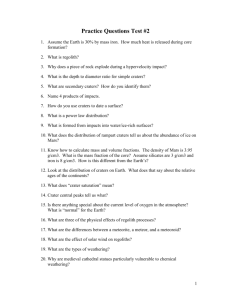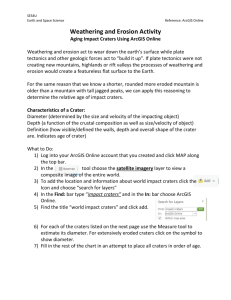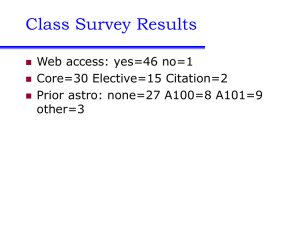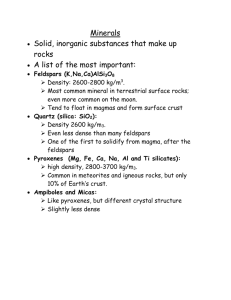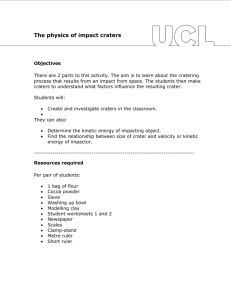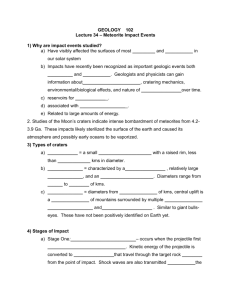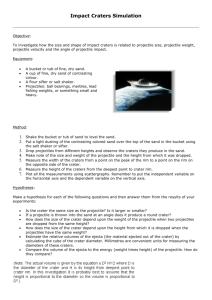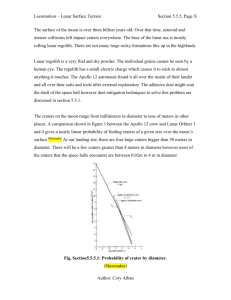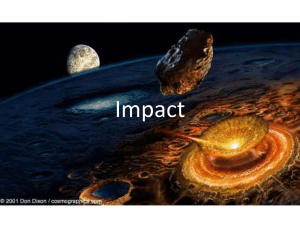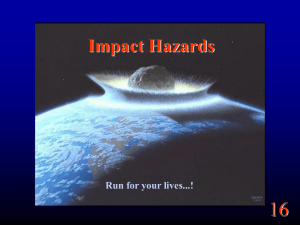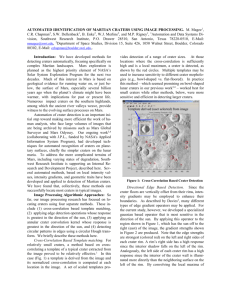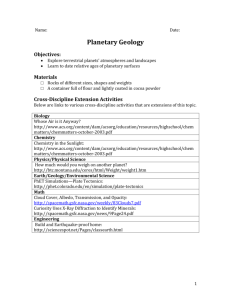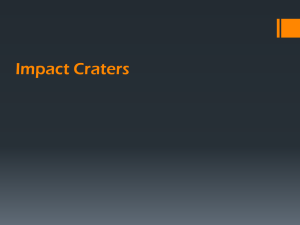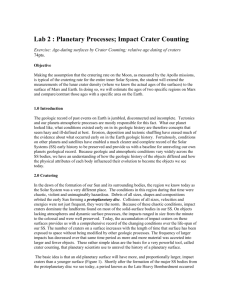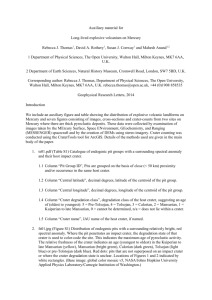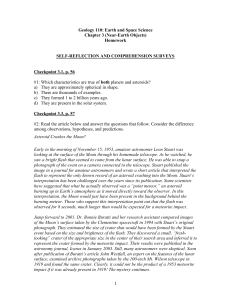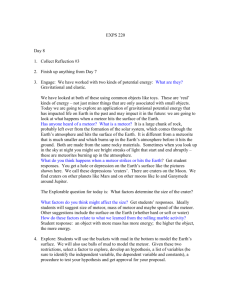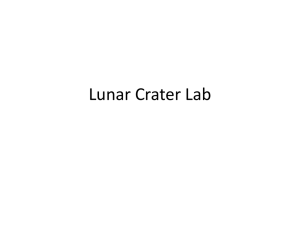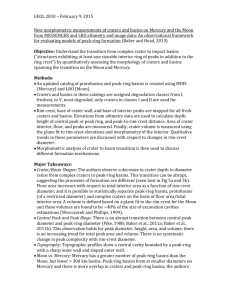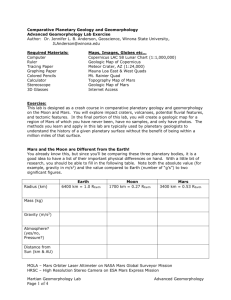Instructions file for the activity
advertisement
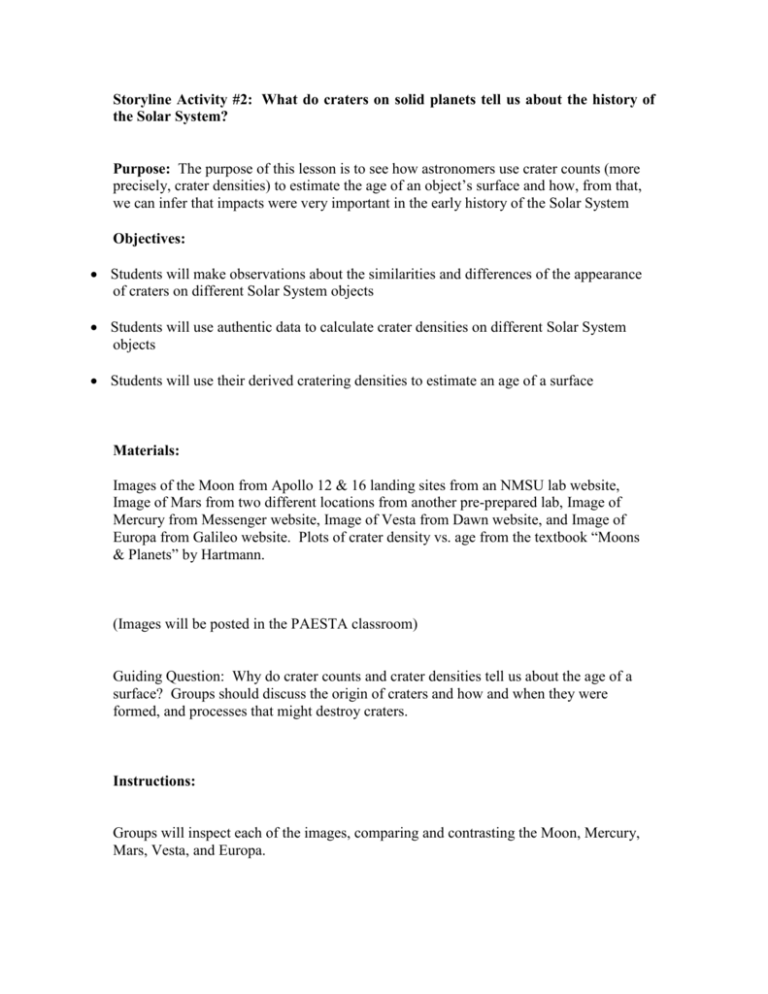
Storyline Activity #2: What do craters on solid planets tell us about the history of the Solar System? Purpose: The purpose of this lesson is to see how astronomers use crater counts (more precisely, crater densities) to estimate the age of an object’s surface and how, from that, we can infer that impacts were very important in the early history of the Solar System Objectives: Students will make observations about the similarities and differences of the appearance of craters on different Solar System objects Students will use authentic data to calculate crater densities on different Solar System objects Students will use their derived cratering densities to estimate an age of a surface Materials: Images of the Moon from Apollo 12 & 16 landing sites from an NMSU lab website, Image of Mars from two different locations from another pre-prepared lab, Image of Mercury from Messenger website, Image of Vesta from Dawn website, and Image of Europa from Galileo website. Plots of crater density vs. age from the textbook “Moons & Planets” by Hartmann. (Images will be posted in the PAESTA classroom) Guiding Question: Why do crater counts and crater densities tell us about the age of a surface? Groups should discuss the origin of craters and how and when they were formed, and processes that might destroy craters. Instructions: Groups will inspect each of the images, comparing and contrasting the Moon, Mercury, Mars, Vesta, and Europa. Using just visual inspection of the images, groups will write a claim about the nature of the differences in the appearance and density of the craters on the various surfaces, supporting their claim with evidence from the images. Each group will use the images to (1) calculate the area of their assigned region on their assigned object (e.g., the Apollo 12 landing site on the Moon), and (2) count the number of craters in two different size bins (e.g., all craters ~8 km and ~32 km in diameter). To compare most easily with the calibration plots, the range should go from 5.6 to 11.3 km and 22.6 to 45.2 km to compare to the 8 km and 32 km bin. Using the area calculated, they will convert their crater counts into a crater density by dividing the number of craters counted by the total area of the photo (the number of craters per square kilometer). For the Moon images, the scale can be estimated from the size of crater Theon Senior (18 km in diameter) and crater Eppinger (6 km in diameter). For the other images, the scales are: Mercury: 150 km x 150 km Vesta: 135 km x 135 km Mars Viking I Landing Site: 228 km x 245 km & Western Chryse Plain: 228 km x 262 km Europa: 335 km x 365 km The crater densities will be compared to the plots from the textbook to estimate an age of the surface. Each group will then write on their whiteboard their results -- (most likely a 2D plot -size of crater vs. crater density). Groups will share out their crater densities to compare and contrast the different values for this number and the derived age for the different areas studied. Following the data share-out, each group will reconvene and discuss their individual results to determine if they can explain the relative age (e.g., very old, somewhat old, somewhat young...) of the various objects studied. They will then write their claim, evidence, and reasoning about the age of the different regions on their whiteboard for a second share-out. Sample Claim, Evidence, Reasoning for this activity: Claim: Europa has the most active surface of the objects studied Evidence: All of the objects studied had cratered surfaces that varied from heavily cratered to few craters. In our study of the photographs of Europa, we could see no craters at all, except for a few places that looked like craters that had been mostly erased. Reasoning: We know that on Earth there are processes that erase craters over time, and we know that there are not nearly as many craters visible on Earth as on the Moon. So we think that Europa must have similar, active processes for wiping away craters like the Earth.


